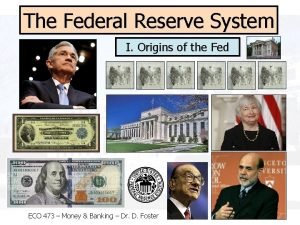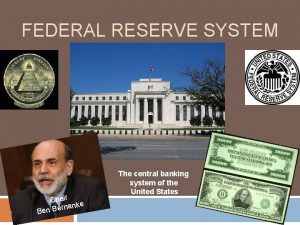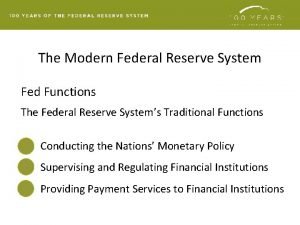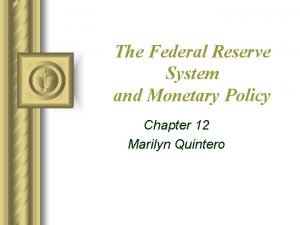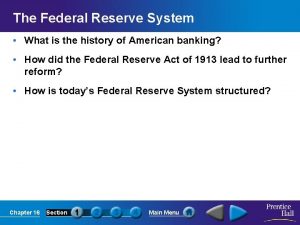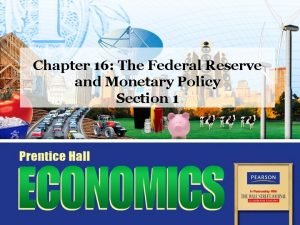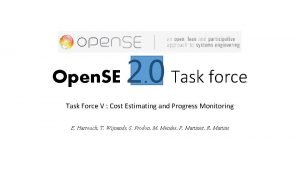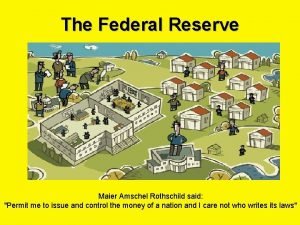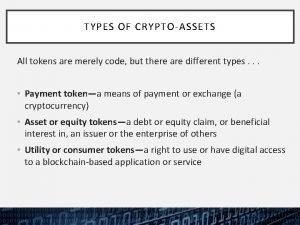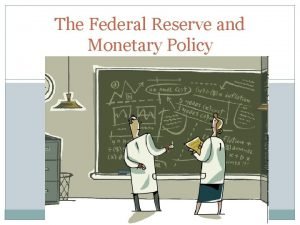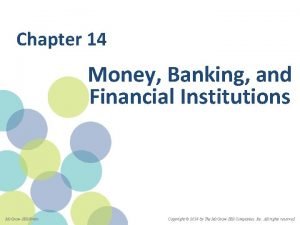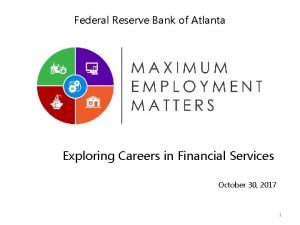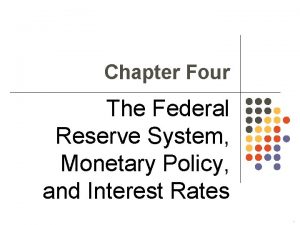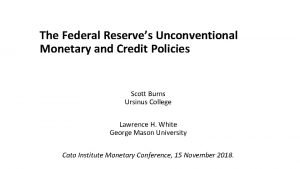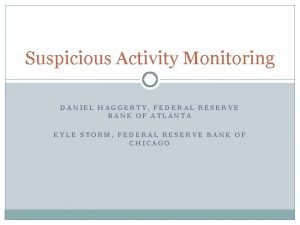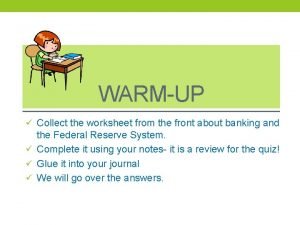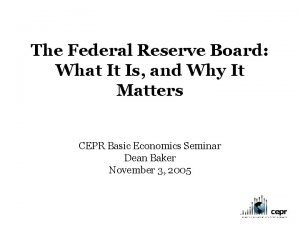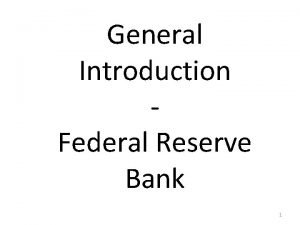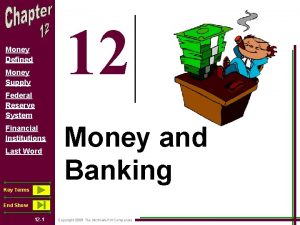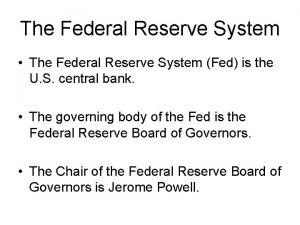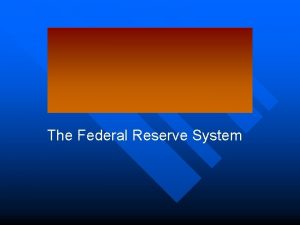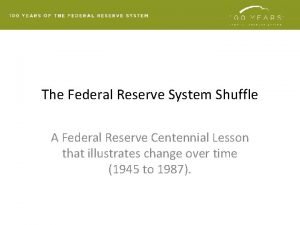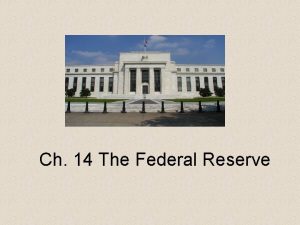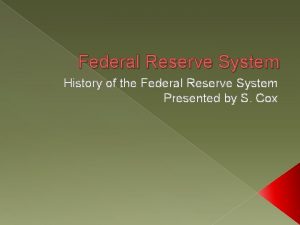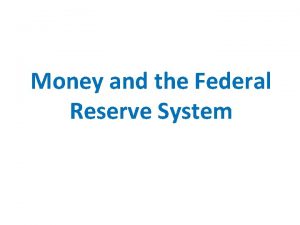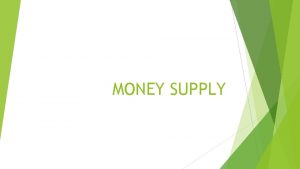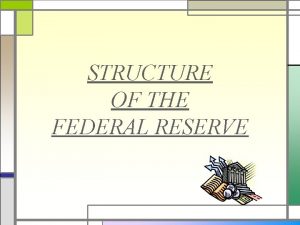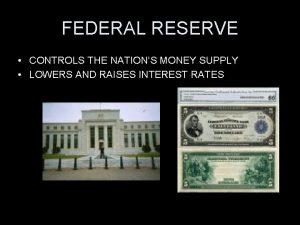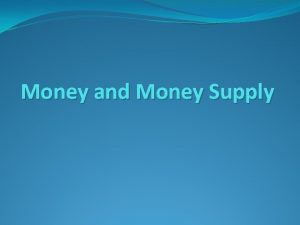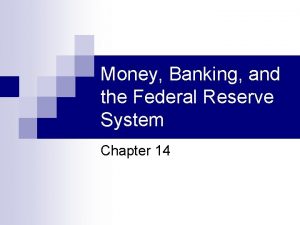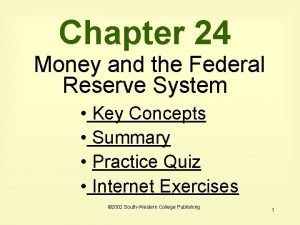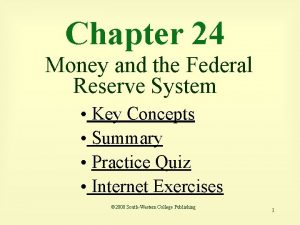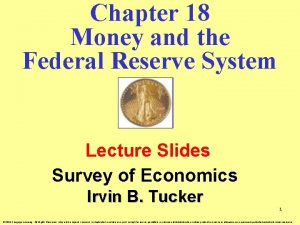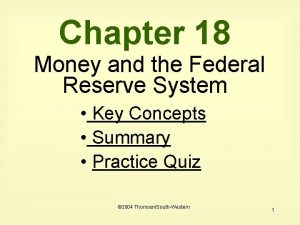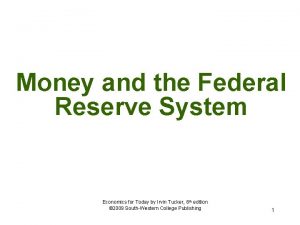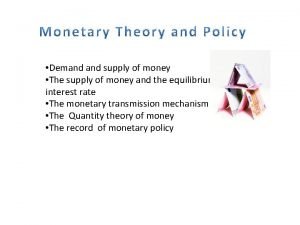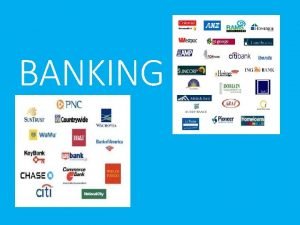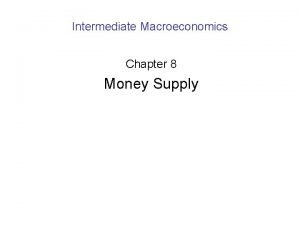The Money Supply and the Federal Reserve System



























- Slides: 27

The Money Supply and the Federal Reserve System 25 CHAPTER OUTLINE An Overview of Money What Is Money? Commodity and Fiat Monies Measuring the Supply of Money in the United States The Private Banking System PART V The Core of Macroeconomic Theory How Banks Create Money © 2012 Pearson Education A Historical Perspective: Goldsmiths The Modern Banking System The Creation of Money The Money Multiplier The Federal Reserve System Functions of the Federal Reserve Expanded Fed Activities Beginning in 2008 The Federal Reserve Balance Sheet How the Federal Reserve Controls the Money Supply The Required Reserve Ratio The Discount Rate Open Market Operations Excess Reserves and the Supply Curve for Money Looking Ahead 1 of 33

An Overview of Money What Is Money? Money is a means of payment, a store of value, and a unit of account. A Means of Payment, or Medium of Exchange PART V The Core of Macroeconomic Theory barter The direct exchange of goods and services for other goods and services. © 2012 Pearson Education medium of exchange, or means of payment What sellers generally accept and buyers generally use to pay for goods and services. 2 of 33

An Overview of Money What Is Money? A Store of Value PART V The Core of Macroeconomic Theory store of value An asset that can be used to transport purchasing power from one time period to another. © 2012 Pearson Education liquidity property of money The property of money that makes it a good medium of exchange as well as a store of value: It is portable and readily accepted and thus easily exchanged for goods. A Unit of Account unit of account A standard unit that provides a consistent way of quoting prices. 3 of 33

An Overview of Money Commodity and Fiat Monies commodity monies Items used as money that also have intrinsic value in some other use. PART V The Core of Macroeconomic Theory fiat, or token, money Items designated as money that are intrinsically worthless. legal tender Money that a government has required to be accepted in settlement of debts. currency debasement The decrease in the value of money that occurs when its supply is increased rapidly. © 2012 Pearson Education 4 of 33

An Overview of Money Measuring the Supply of Money in the United States M 1: Transactions Money PART V The Core of Macroeconomic Theory M 1, or transactions money Money that can be directly used for transactions. © 2012 Pearson Education M 1 ≡ currency held outside banks + demand deposits + traveler’s checks + other checkable deposits 5 of 33

An Overview of Money Measuring the Supply of Money in the United States M 2: Broad Money PART V The Core of Macroeconomic Theory near monies Close substitutes for transactions money, such as savings accounts and money market accounts. © 2012 Pearson Education M 2, or broad money M 1 plus savings accounts, money market accounts, and other near monies. M 2 ≡ M 1 + savings accounts + money market accounts + other near monies 6 of 33

An Overview of Money Measuring the Supply of Money in the United States Beyond M 2 There are no rules for deciding what is and is not money. PART V The Core of Macroeconomic Theory This poses problems for economists and those in charge of economic policy. © 2012 Pearson Education 7 of 33

An Overview of Money The Private Banking System financial intermediaries Banks and other institutions that act as a link between those who have money to lend and those who want to borrow money. PART V The Core of Macroeconomic Theory The main types of financial intermediaries are commercial banks, followed by savings and loan associations, life insurance companies, and pension funds. © 2012 Pearson Education 8 of 33

How Banks Create Money A Historical Perspective: Goldsmiths run on a bank Occurs when many of those who have claims on a bank (deposits) present them at the same time. PART V The Core of Macroeconomic Theory Today’s bankers differ from goldsmiths—today’s banks are subject to a “required reserve ratio. ” Goldsmiths had no legal reserve requirements, although the amount they loaned out was subject to the restriction imposed on them by their fear of running out of gold. © 2012 Pearson Education 9 of 33

How Banks Create Money The Modern Banking System A Brief Review of Accounting PART V The Core of Macroeconomic Theory Assets − Liabilities ≡ Net Worth or Assets ≡ Liabilities + Net Worth © 2012 Pearson Education Federal Reserve Bank (the Fed) The central bank of the United States. reserves The deposits that a bank has at the Central bank plus its cash on hand. required reserve ratio The percentage of its total deposits that a bank must keep as reserves at the Central Bank. 10 of 33

How Banks Create Money The Modern Banking System PART V The Core of Macroeconomic Theory A Brief Review of Accounting FIGURE 25. 1 T-Account for a Typical Bank (millions of dollars) The balance sheet of a bank must always balance, so that the sum of assets (reserves and loans) equals the sum of liabilities (deposits and net worth). © 2012 Pearson Education 11 of 33

How Banks Create Money The Creation of Money excess reserves The difference between a bank’s actual reserves and its required reserves. PART V The Core of Macroeconomic Theory excess reserves ≡ actual reserves − required reserves FIGURE 25. 2 Balance Sheets of a Bank in a Single-Bank Economy In panel 2, there is an initial deposit of $100. In panel 3, the bank has made loans of $400. © 2012 Pearson Education 12 of 33

How Banks Create Money PART V The Core of Macroeconomic Theory The Creation of Money FIGURE 25. 3 The Creation of Money When There Are Many Banks In panel 1, there is an initial deposit of $100 in bank 1. In panel 2, bank 1 makes a loan of $80 by creating a deposit of $80. A check for $80 by the borrower is then written on bank 1 (panel 3) and deposited in bank 2 (panel 1). The process continues with bank 2 making loans and so on. In the end, loans of $400 have been made and the total level of deposits is $500. © 2012 Pearson Education 13 of 33

How Banks Create Money The Money Multiplier An increase in bank reserves leads to a greater than one-for-one increase in the money supply. PART V The Core of Macroeconomic Theory Economists call the relationship between the final change in deposits and the change in reserves that caused this change the money multiplier The multiple by which deposits can increase for every dollar increase in reserves; equal to 1 divided by the required reserve ratio. © 2012 Pearson Education 14 of 33

The Federal Reserve System Functions of the Central Bank (CB) From a macroeconomic point of view, the CB’s crucial role is to control the money supply. PART V The Core of Macroeconomic Theory The CB also performs several important functions for banks, such as clearing interbank payments, regulating the banking system, and assisting banks in a difficult financial position. The CB is also responsible for managing exchange rates and the nation’s foreign exchange reserves. It is often involved in intercountry negotiations on international economic issues. lender of last resort One of the functions of the CB: It provides funds to troubled banks that cannot find any other sources of funds. © 2012 Pearson Education 15 of 33

The Federal Reserve System The Federal Reserve Balance Sheet TABLE 25. 1 Assets and Liabilities of the Federal Reserve System, June 30, 2010 (Billions of Dollars) Assets PART V The Core of Macroeconomic Theory Gold Liabilities 11 $ 945 U. S. Treasury securities 777 970 Reserve balances Federal agency debt securities 165 288 U. S. Treasury deposits 1, 118 170 All other liabilities and net worth 302 $2, 373 Mortgage-backed securities All other assets Total © 2012 Pearson Education $ Currency in circulation Total $2, 373 16 of 33

How the Central Bank Controls the Money Supply If the CB wants to increase the supply of money, it creates more reserves, thereby freeing banks to create additional deposits by making more loans. If it wants to decrease the money supply, it reduces reserves. Three tools are available to the CB for changing the money supply: (1) Changing the required reserve ratio. PART V The Core of Macroeconomic Theory (2) Changing the discount rate. (3) Engaging in open market operations. © 2012 Pearson Education 17 of 33

How the CB Controls the Money Supply The Required Reserve Ratio TABLE 25. 2 A Decrease in the Required Reserve Ratio from 20 Percent to 12. 5 Percent Increases the Supply of Money (All Figures in Billions of Dollars) Panel 1: Required Reserve Ratio = 20% Federal Reserve Assets PART V The Core of Macroeconomic Theory Government securities Commercial Banks Liabilities $200 Assets $100 Reserves $100 Currency Loans $400 Liabilities $500 Deposits Note: Money supply (M 1) = Currency + Deposits = $600. Panel 2: Required Reserve Ratio = 12. 5% Federal Reserve Assets Government securities $200 Commercial Banks Liabilities Assets Liabilities $100 Reserves $100 $800 $100 Currency Loans (+ $300) $700 (+ $300) Deposits Note: Money supply (M 1) = currency + deposits = $900. © 2012 Pearson Education 18 of 33

How the Federal Reserve Controls the Money Supply The Required Reserve Ratio Decreases in the required reserve ratio allow banks to have more deposits with the existing volume of reserves. PART V The Core of Macroeconomic Theory As banks create more deposits by making loans, the supply of money (currency + deposits) increases. The reverse is also true: If the CB wants to restrict the supply of money, it can raise the required reserve ratio, in which case banks will find that they have insufficient reserves and must therefore reduce their deposits by “calling in” some of their loans. The result is a decrease in the money supply. © 2012 Pearson Education 19 of 33

How the Federal Reserve Controls the Money Supply The Discount Rate discount rate The interest rate that banks pay to the CB to borrow from it. PART V The Core of Macroeconomic Theory moral suasion The pressure that in the past the CB exerted on member banks to discourage them from borrowing heavily from the CB. © 2012 Pearson Education 20 of 33

How the Federal Reserve Controls the Money Supply The Discount Rate TABLE 25. 3 The Effect on the Money Supply of Commercial Bank Borrowing from the Fed (All Figures in Billions of Dollars) Panel 1: No Commercial Bank Borrowing from the Federal Reserve Assets Liabilities PART V The Core of Macroeconomic Theory Securities $160 Commercial Banks Assets Liabilities $80 Reserves $80 Currency Loans $80 $400 Deposits $320 Note: Money supply (M 1) = currency + deposits = $480. Panel 2: Commercial Bank Borrowing $20 from the Federal Reserve Assets Liabilities Securities Loans Commercial Banks Assets Liabilities $160 $100 Reserves (+ $20) $100 $500 $20 $80 Currency Loans (+ $100) $420 $20 Deposits (+ $300) Amount owed to Fed (+ $20) Note: Money supply (M 1) = currency + deposits = $580. © 2012 Pearson Education 21 of 33

How the Federal Reserve Controls the Money Supply Open Market Operations open market operations The purchase and sale by the CB of government securities in the open market; a tool used to expand or contract the amount of reserves in the system and thus the money supply. PART V The Core of Macroeconomic Theory Two Branches of Government Deal in Government Securities © 2012 Pearson Education The Treasury Department is responsible for collecting taxes and paying the government’s bills. The CB is not the Treasury. It is a quasi-independent agency authorized to buy and sell outstanding (preexisting) Turkish. government securities on the open market. 22 of 33

How the Federal Reserve Controls the Money Supply Open Market Operations The Mechanics of Open Market Operations TABLE 25. 4 Open Market Operations (The Numbers in Parentheses in Panels 2 and 3 Show the Differences between Those Panels and Panel 1. All Figures in Billions of Dollars) Panel 1 Federal Reserve Assets Liabilities Securities $100 $20 Reserves $80 Currency Commercial Banks Assets Liabilities Reserves Loans $20 $80 $100 Deposits Jane Q. Public Assets Liabilities Deposits $5 $0 $5 Debts Net Worth PART V The Core of Macroeconomic Theory Note: Money supply (M 1) = Currency + Deposits = $180. Panel 2 Federal Reserve Assets Liabilities Securities ( $5) $95 $15 Reserves ( $5) $80 Currency Commercial Banks Assets Liabilities Reserves ( $5) Loans $15 $95 Deposits ( $5) $80 Jane Q. Public Assets Liabilities Deposits ( $5) Securities (+ $5) $0 $0 Debts $5 $5 Net Worth Note: Money supply (M 1) = Currency + Deposits = $175. Panel 3 Federal Reserve Assets Liabilities Securities ( $5) $95 $15 Reserves ( $5) $80 Currency Commercial Banks Assets Liabilities Reserves ( $5) Loans ( $20) $15 $60 $75 Deposits ( $25) Jane Q. Public Assets Liabilities Deposits ( $5) Securities (+ $5) $0 $0 Debts $5 $5 Net Worth Note: Money supply (M 1) = Currency + Deposits = $155. © 2012 Pearson Education 23 of 33

How the Federal Reserve Controls the Money Supply Open Market Operations The Mechanics of Open Market Operations PART V The Core of Macroeconomic Theory We can sum up the effect of these open market operations this way: © 2012 Pearson Education ■ An open market purchase of securities by the CB results in an increase in reserves and an increase in the supply of money by an amount equal to the money multiplier times the change in reserves. ■ An open market sale of securities by the CB results in a decrease in reserves and a decrease in the supply of money by an amount equal to the money multiplier times the change in reserves. 24 of 33

How the Federal Reserve Controls the Money Supply PART V The Core of Macroeconomic Theory Excess Reserves and the Supply Curve for Money FIGURE 25. 5 The Supply of Money If the CB’s money supply behavior is not influenced by the interest rate, the money supply curve is a vertical line. Through its three tools, the CB is assumed to have the money supply be whatever value it wants. © 2012 Pearson Education 25 of 33

Looking Ahead This chapter has discussed only the supply side of the money market. In the next chapter, we turn to the demand side of the money market. PART V The Core of Macroeconomic Theory We will examine the demand for money and see how the supply of and demand for money determine the equilibrium interest rate. © 2012 Pearson Education 26 of 33

PART V The Core of Macroeconomic Theory REVIEW TERMS AND CONCEPTS barter moral suasion commodity monies near monies currency debasement Open Market Desk discount rate open market operations excess reserves required reserve ratio Federal Open Market Committee (FOMC) reserves Federal Reserve Bank (the Fed) run on a bank fiat, or token, money store of value financial intermediaries unit of account legal tender 1. M 1 ≡ currency held outside banks + demand deposits + traveler’s checks + other checkable deposits lender of last resort liquidity property of money M 1, or transactions money 2. M 2 ≡ M 1 + savings accounts + money market accounts + other near monies M 2, or broad money 3. Assets ≡ Liabilities + Net Worth medium of exchange, or means of payment 4. Excess reserves ≡ actual reserves − required reserves money multiplier © 2012 Pearson Education 5. Money multiplier ≡ 27 of 33
 Source of capital reserve
Source of capital reserve Difference between capital reserve and reserve capital
Difference between capital reserve and reserve capital Federal reserve system
Federal reserve system Fractional banking
Fractional banking Federal reserve system
Federal reserve system Fed functions
Fed functions The three parts of the federal reserve system
The three parts of the federal reserve system Ferderal reserve system
Ferderal reserve system Federal reserve pyramid
Federal reserve pyramid The federal reserve system is overseen by the
The federal reserve system is overseen by the The federal reserve system worksheet answers
The federal reserve system worksheet answers Contingency reserve vs management reserve
Contingency reserve vs management reserve Dana damian
Dana damian Rothschild federal reserve
Rothschild federal reserve The fed today video questions answers
The fed today video questions answers Federal reserve jurisdiction
Federal reserve jurisdiction Structure of the federal reserve
Structure of the federal reserve Banking panics
Banking panics Federal reserve dual mandate
Federal reserve dual mandate Federal reserve bank of atlanta careers
Federal reserve bank of atlanta careers Federal reserve bank omaha
Federal reserve bank omaha Federal reserve
Federal reserve Federal reserve
Federal reserve Suspicious activity monitoring
Suspicious activity monitoring Jekyll island fed
Jekyll island fed The federal reserve note warm up activity answers
The federal reserve note warm up activity answers Federal reserve bank
Federal reserve bank Federal reserve bank
Federal reserve bank


